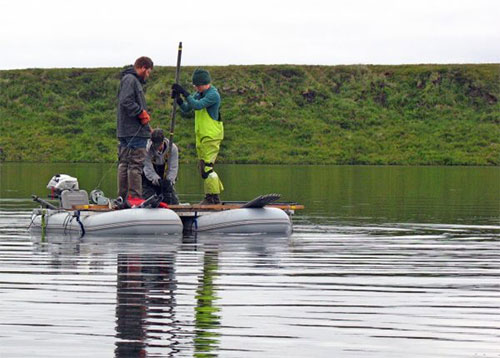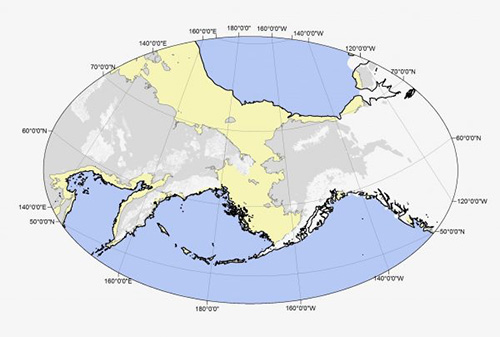
Was the Bering land bridge a good place to live?By NED ROZELL
February 26, 2018
That mysterious land of green plants, streams and hills persisted for thousands of years, until seas swelling with glacial melt ate it up. All that remains are mountaintops that are now St. Lawrence and other islands, and the outline on maps that shows the continental shelf spreading underwater like pancake batter.
Those who have spent their careers pondering Earth’s not-so-distant past wonder if the land bridge was a good place to live. Genetic information shows native North Americans split from Eurasians about 20,000 years ago. The earliest human sites in Alaska date to about 14,200 years ago. Could people have been living on the land bridge during that gap? At a seminar at the University of Alaska Fairbanks, Nancy Bigelow pointed to a map showing Earth 21,000 years ago. The current sites of New York and Chicago were buried beneath blue glacier ice. Fairbanks and Nome were not. All of the land bridge, about the size of mid-America, was perhaps a green oasis between ice sheets. A computer model suggests the southern portion of the land bridge was warmer than the continents that walled it in. “Is this is a land people could have lived on?” said Bigelow, an ecologist at the university who gathers evidence like pollen and leaf fossils and imagines ancient landscapes. She is the director of UAF’s Alaska Quaternary Center. She wonders if generations of people paused there, on their way to populating North America from Asia. Or whether they gritted their teeth and busted through as fast as they could.
“Was it too cold and nasty for humans?” Bigelow asked. Like the paleo-detective she is, Bigelow presented evidence that woody plants could have grown on at least parts of the land bridge. That evidence is hard to come by; most of the land bridge is now 400 feet under water. Bigelow has pulled cores from the bottom of lakes in western Alaska to find pollen grains and bits of ancient plants. She also studies examples of others’ work, citing a 9,000-year-old spruce twig found on the Seward Peninsula, pine pollen from a lake in Siberia, and spruce, alder and birch pollen in a core pulled from the ocean floor off Alaska and analyzed by UAF graduate student Rachel Westbrook. “If you’ve got spruce, birch and alder, you’ve got some sort of woodland,” Bigelow said. “If you have a ready supply of wood, it makes living a lot easier.” The land bridge might have been a place where birch and possibly spruce endured in protected spots when those trees and shrubs did not exist elsewhere in Alaska. Perhaps the land bridge was a place where our species could hang around for a few thousand years. Bigelow said plants from the ancient land mass during the last ice age are similar to those on today’s Wrangel Island, north of Siberia and the last known home of woolly mammoths. Wrangel Island is a dry, cold place that’s home to tundra plants and a few shrubs. Northern Alaskans have thrived in similar landscapes for a long time.
Representations of fact and opinions in comments posted are solely those of the individual posters and do not represent the opinions of Sitnews.
|
|||||

